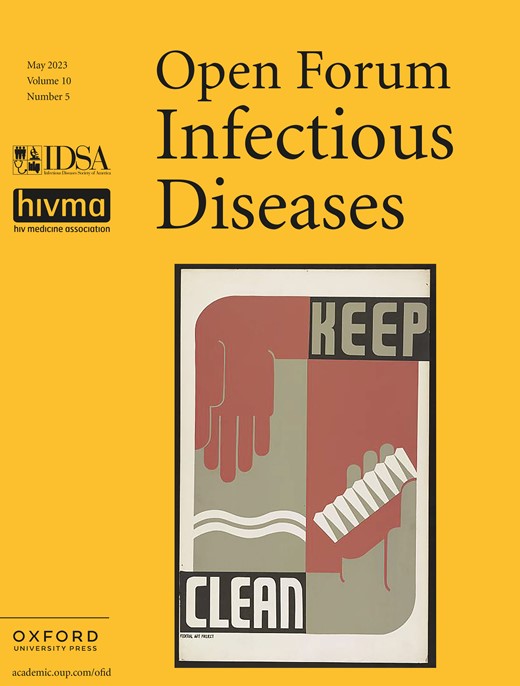
Cover image

Volume 10, Issue 5, May 2023
Major Articles
Using Thermal Imaging to Track Cellulitis
“To Be Honest, You Probably Would Have to Read It 50 Times”: Stakeholders Views on Using the Opt-Out Approach for Vaccination in Jails
The opt-out approach to infectious diseases testing is a recommended strategy to increase diagnosis and prevention of disease. We engaged stakeholders within jail healthcare to understand barriers and facilitators to the implementation of opt-out for vaccination in jails.
Effectiveness of Casirivimab and Imdevimab Antibody Combination in Immunocompromised Hospitalized Patients With Coronavirus Disease 2019: A Post Hoc Analysis in a Phase 1/2/3 Double–Blind Trial
In a post hoc analysis of hospitalized patients with COVID-19, immunocompromised patients were more frequently seronegative and had higher baseline viral loads. In both immunocompromised and overall study patients, casirivimab plus imdevimab reduced viral load and mechanical ventilation or death without new safety findings.
A Systematic Review on the Safety of Mycobacterium tuberculosis–Specific Antigen–Based Skin Tests for Tuberculosis Infection Compared With Tuberculin Skin Tests
Tuberculosis-specific skin tests have been shown to be similar in accuracy to interferon γ release assays. Our systematic review found that tuberculosis-specific skin tests are similar in safety to tuberculin skin tests and are mostly associated with mild injection site reactions.
Latent Tuberculosis Infection Treatment Practices in Two Large Integrated Health Systems in California, 2009–2018
Among 79,302 adults with a positive latent tuberculosis infection (LTBI) test from 2009-2018, only 33% were prescribed treatment and 19% completed treatment. Additional efforts are needed to increase treatment prescription and completion for patients with LTBI
ID Teaching Cases
Anaplasmosis-Induced Hemophagocytic Lymphohistiocytosis: A Case Report and Review of the Literature
A 78-year old man presented one month after a tick bite with fever and lab findings consistent with hemophagocytic lymphohistiocytosis. Morulae were visualized in the bone marrow biopsy and serum PCR confirmed Anaplasma phagocytophilum. He improved on doxycycline and steroids.
Perspectives
Principles and Terminology for Host–Microbiome–Drug Interactions
In this viewpoint article we define terminology to describe the bidirectional interactions between the microbiome and medical interventions. Pharmacomicrobiomics describes the unidirectional effects of microbiomes on bioavailability and bioactivity of drugs. Here we define pharmacoecology as the effects of medical interventions on microbiome composition and function.
Major Articles
Characterization of Rare Spontaneous Human Immunodeficiency Virus Viral Controllers Attending a National United Kingdom Clinical Service Using a Combination of Serology and Molecular Diagnostic Assays
Syndromic Panel Testing Among Patients With Infectious Diarrhea: The Challenge of Interpreting Clostridioides difficile Positivity on a Multiplex Molecular Panel
Clostridioides difficile (CD) is commonly detected in a gastrointestinal multiplex molecular panel. Alternative testing yielded discordant results in a significant proportion, yet treatment was common. CD results in molecular panels should be interpreted with caution in the setting of low pretest probability.
Large Diffusion of Severe Acute Respiratory Syndrome Coronavirus 2 After the Successive Epidemiological Waves, Including Omicron, in Guinea and Cameroon: Implications for Vaccine Strategies
The overall age-standardized SARS-CoV-2 IgG seroprevalence against spike and nucleocapsid proteins was 71.57% in Guinea and 74.71% in Cameroon after successive COVID-19 waves, including the Omicron wave from early 2022. Seroprevalence increased with age categories reaching 84% among persons >40 years.
Hybrid Immunity Provides Protective Advantage Over Vaccination or Prior Remote Coronavirus Disease 2019 Alone
COVID-19 mRNA vaccination was associated with lower risk of COVID-19, including in those with prior COVID-19. Vaccination should be encouraged for those with remote prior infection, especially as new variants emerge and variant-specific booster vaccines become available.
A Real-world Multicenter Outpatient Experience of Ceftolozane/Tazobactam
C/T was successfully used in patients with a variety of serious infections, significant comorbidities, and a high prevalence of resistant pathogens in the outpatient setting.
Assessing Empiric Antimicrobial Therapy With the Modified Dundee Classification for Nonpurulent Skin and Soft Tissue Infections in a Community Hospital System
The modified Dundee classification has recently been validated as the first scoring tool for non-purulent skin and soft tissue infections. This descriptive study uniquely applies this classification scheme toward optimizing antimicrobial stewardship and ultimately patient care.
Risk of Pneumococcal Disease in US Adults by Age and Risk Profile
Neutralizing Antibody Responses to Messenger RNA Coronavirus Disease 2019 Vaccines Versus Severe Acute Respiratory Syndrome Coronavirus 2 Infection Among Pregnant Women and Vaccine-Induced Antibody Transfer to Infants
Epidemiology of Sepsis in US Children and Young Adults
Among 736 US children and young adults with sepsis, 83% had community-onset sepsis. Most patients had underlying conditions, recent healthcare interactions were common, and age group–related differences were observed, suggesting opportunities to improve early recognition and clinical intervention.
Host Expression Profiling From Diagnostic Coronavirus Disease 2019 Swabs Associates Upper Respiratory Tract Immune Responses With Radiologic Lung Pathology and Clinical Severity
Containment of a Verona Integron-Encoded Metallo-Beta-Lactamase-Producing Pseudomonas aeruginosa Outbreak Associated With an Acute Care Hospital Sink—Tennessee, 2018–2020
Outbreaks of multidrug-resistant organisms linked to environmental reservoirs can be difficult to detect, which can result in persistent transmission for years. We describe an outbreak linked to intensive care unit sink drains in an acute care hospital.
Factors Associated With Enrollment into Inpatient Coronavirus Disease 2019 Randomized Controlled Trials: A Cross-sectional Analysis
In this study, we report differences in the willingness to enroll into inpatient COVID-19 clinical trials when invited among various patient populations. Our findings underscore the need for tailored and inclusive recruitment strategies to achieve diverse clinical trial enrollment.
Clinical Characteristics of the 2019 Eastern Equine Encephalitis Outbreak in Michigan
Severe Acute Respiratory Syndrome Coronavirus 2 Neutralizing Antibody Responses After Community Infections in Children and Adults
Effectiveness of Booster Doses of Monovalent mRNA COVID-19 Vaccine Against Symptomatic Severe Acute Respiratory Syndrome Coronavirus 2 Infection in Children, Adolescents, and Adults During Omicron Subvariant BA.2/BA.2.12.1 and BA.4/BA.5 Predominant Periods
Individuals with 1 or 2 monovalent mRNA COVID-19 booster doses were less likely to have symptomatic SARS-CoV-2 infection compared to those without booster doses, during the BA.2/BA.2.12.1 and BA.4/BA.5 predominant subvariant periods.
Immunogenicity, Safety, and Breakthrough Severe Acute Respiratory Syndrome Coronavirus 2 Infections After Coronavirus Disease 2019 Vaccination in Organ Transplant Recipients: A Prospective Multicenter Canadian Study
Respiratory Syncytial Virus–Related Complications and Healthcare Costs Among a Medicare-Insured Population in the United States
In this real-world study, nearly half of Medicare beneficiaries experienced a respiratory syncytial virus (RSV)–related complication within 1 month of RSV diagnosis. Presence of complications/comorbidities of interest pre–RSV diagnosis predicted a higher risk of having a different complication following diagnosis.
Persistence of Human Immunodeficiency Virus–Associated Cerebral Toxoplasmosis Lesions in Successfully Treated Patients Receiving Combination Antiretroviral Therapy
In people with HIV and toxoplasmic encephalitis who demonstrate immune reconstitution while receiving antiretroviral therapy, contrast enhancement of magnetic resonance imaging lesions can persist for years following clinical improvement. Such persistence may not indicate active disease requiring therapy.
Investigation of Blood Plasma Viral Nucleocapsid Antigen as a Marker of Active Severe Acute Respiratory Syndrome Coronavirus 2 Omicron Variant Infection
Beyond Undetectable: Modeling the Clinical Benefit of Improved Antiretroviral Adherence in Persons With Human Immunodeficiency Virus With Virologic Suppression
Factors Associated With Coronavirus Disease 2019 Vaccine Uptake Among Pregnant Women and Nonpregnant Women of Reproductive Age in Jamaica
In our study, pregnancy, low vaccine confidence, and government mistrust were associated with a lower likelihood of COVID-19 vaccination among reproductive-aged women in Jamaica.
Compassionate Use of Bacteriophages for Failed Persistent Infections During the First 5 Years of the Israeli Phage Therapy Center
Factors Associated With the Development of Bacterial Pneumonia Related to Seasonal Influenza Virus Infection: A Study Using a Large-scale Health Insurance Claim Database
Safety and Effectiveness of Miltefosine in Post–Kala-Azar Dermal Leishmaniasis: An Observational Study
Oral miltefosine is the first-line treatment for post–kala-azar dermal leishmaniasis in South Asia. This study assessed safety and effectiveness of miltefosine. The cure rate was 76%; however, a significant number of patients developed ocular complications.
Enterococci in Diabetic Foot Infections: Prevalence, Clinical Characteristics, and Outcomes
The Impact of Neisseria gonorrhoeae Mono- and Coinfection on Adverse Pregnancy Outcomes
Prenatal Neisseria gonorrhoeae may increase the odds of preterm preeclampsia and preterm delivery. Even with screening and treatment, our study and the work of others show that gonorrhea may still negatively impact pregnancy health.
Retrospective Analysis of the Safety and Efficacy of Fecal Microbiota, Live-jslm (REBYOTATM) Administered Under Enforcement Discretion to Patients With Clostridioides difficile Infection
Plasmodium 18S Ribosomal RNA Biomarker Clearance After Food and Drug Administration–Approved Antimalarial Treatment in Controlled Human Malaria Infection Trials
Posttreatment Plasmodium 18S ribosomal RNA molecular diagnostic data were assessed from multiple controlled human malaria infection studies to ascertain the clearance kinetics of this increasingly used biomarker. All participants showed complete clearance by 7 days after treatment initiation.
Review Articles
The Impact of Initial Specimen Diversion Systems on Blood Culture Contamination
Blood culture contamination is associated with unnecessary antibiotic use and hospital cost. Blood culture diversion techniques have been implemented with varying methods and results. This literature review highlights the need for a meta-analysis to inform providers about the optimal technique.
The Impact of Antimicrobial Therapy Duration in the Treatment of Prosthetic Joint Infections Depending on Surgical Strategies: A Systematic Review and Meta-analysis
In this systematic review and meta-analysis, we found no difference in treatment failure for prosthetic joint infections with shorter compared to longer antibiotic treatment, irrespective of the type of surgical procedure (debridement, antibiotics, and implant retention vs 1- or 2-stage exchange arthroplasty).
Brief Reports
Unexpected Increase in Invasive Group A Streptococcal Infections in Children After Respiratory Viruses Outbreak in France: A 15-Year Time-Series Analysis
Since October 2022, an increase in invasive Group A streptococcal (iGAS) infections has been reported. In this 15-year study we showed that this increase was concomitant with intense respiratory viruses' outbreak. Physicians should be aware of this increased risk of pediatric iGAS infections.
Baricitinib Treatment of Coronavirus Disease 2019 Is Associated With a Reduction in Secondary Infections
Limited Clinical Impact of Ultralow-Dose Computed Tomography in Suspected Community-Acquired Pneumonia
Patients clinically suspected of community-acquired pneumonia were randomized between ultra-low-dose chest computed tomography (ULDCT, 261 patients) and chest radiograph (CXR, 231 patients). We did not find evidence that performing ULDCT instead of CXR affects antibiotic treatment policy or patient outcomes.







